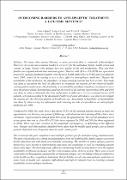| dc.identifier.citation | Odaga, J., Cicciò, L. and Bakaitwoha, E.M., 2008. Overcoming barriers to anti-epileptic treatment: a life-time sentence? Health Policy and Development, 6(1), p.54-65. | en_US |
| dc.description.abstract | Epilepsy, like many other mental illnesses, is more prevalent than is commonly acknowledged. Moreover, its social and economic burden is excessive for the individual, family, health system and country at large. People with epilepsy have low quality of life and productivity. They and their families are stigmatized and discriminated against. Doctors with Africa - CUAMM, has operated a project for epilepsy treatment together with the local health authorities in Nebbi and Arua districts since 2005, aimed at increasing access to free, effective anti-epileptic medicines. Despite the availability of the medicines, the attendance of many enrolled patients has been erratic. This study was done to document the level of adherence to treatment, the reasons for the observed healthseeking pattern and to assess the feasibility of sustainability of enhanced epilepsy treatment services once the project ended. Retrospective analysis of records of all patients registered in 2004 and 2005 was done in order to determine the level and pattern of adherence. A cross-sectional survey of 93 patients, selected according to the documented patterns of clinic attendance, was done to investigate the reasons for the observed pattern of healthcare use. Assessment of feasibility of sustainability was done by interviewing key informants and reviewing records of expenditures on anti-epileptic medicines for 2005.
Conducted in 2006, the study shows that about 84.5% of the enrolled patients missed at least one appointment over the two-year period of follow-up, with about one third missing all the clinics since enrolment. A typical patient missed about 60% of all the appointments. The overall attendance level at any given time was at a low 40% (30% for those registered in 2005 and 50% for those registered in 2004). There was wide variation in the magnitude and frequency of defaulting at the different sites. Younger and older patients defaulted more often than the middle-aged groups, just as female patients defaulted more frequently than the male counterparts.
The reasons for the poor compliance were multiple, patient-specific and often acting simultaneously. The most critical and cross-cutting included distance from the health facility, family support, persistent health education and individual patient/family counseling. The mobilisers (often epilepsy patients themselves) were pivotal in patient/family education and counseling as well as reminding patients about clinic days. The most important adherence-promoting health systems factors were the regular availability of effective medicines and the vertical nature of the delivery system. There were several constraints working against sustainability of enhanced epilepsy care, including technical competence of the health workers, regulatory limitations that forbid the use of some anti-epileptic medicines at some levels of health care, negative staff attitude and high investment levels in ensuring constant availability of anti-epileptic medicines. | en_US |


